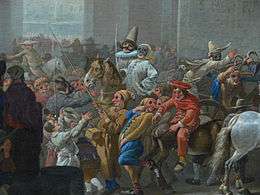Notting Hill Carnival
| Notting Hill Carnival | |
|---|---|
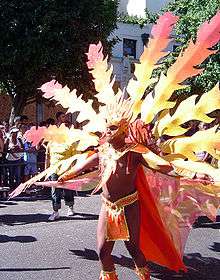 | |
| Genre | Soca music, Calypso music Steelpan music Dancehall |
| Dates | 25–27 August 2018[1] |
| Location(s) |
Notting Hill Ladbroke Grove, Westbourne Grove, Westbourne Park, Westbourne Park, and Kensal Road [2] |
| Years active | 1966–present |
| Attendance | 2 million attendees, 40,000 volunteers and 9,000 police[3] |
The Notting Hill Carnival is an annual event that has taken place in London since 1966[4] on the streets of Notting Hill, in the Royal Borough of Kensington and Chelsea and the City of Westminster, each August over two days (the August bank holiday Monday and the preceding Sunday).[5] It is led by members of the British West Indian community, and attracts around one million people annually, making it one of the world's largest street festivals, and a significant event in Black British culture.[6][7] In 2006, the UK public voted it onto a list of icons of England.[8] Despite its name, it is not part of the global Carnival season preceding Lent.[9]
History
Professor David Dabydeen has stated:
Carnival is not alien to British culture. Bartholomew Fair and Southwark Fair in the 18th century were moments of great festivity and release. There was juggling, pickpocketing, whoring, drinking, masquerade – people dressed up as the Archbishop of Canterbury and indulged in vulgar acts. It allowed people a space to free-up but it was banned for moral reasons and for the antiauthoritarian behaviour that went on like stoning of constables. Carnival allowed people to dramatise their grievances against the authorities on the street... Notting Hill Carnival single-handedly revived this tradition and is a great contribution to British cultural life."[7]
Bartholomew's Fair was suppressed in 1855 by the City authorities for encouraging debauchery and public disorder.
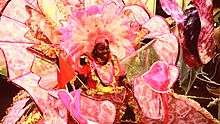
The roots of the Notting Hill Carnival that took shape in the mid-1960s had two separate but connected strands. A "Caribbean Carnival" was held on 30 January 1959[10] in St Pancras Town Hall as a response to the problematic state of race relations at the time; the UK's first widespread racial attacks, the Notting Hill race riots in which 108 people were charged,[11] had occurred the previous year. The 1959 event, held indoors and televised by the BBC, was organised by the Trinidadian Claudia Jones (often described as "the mother of the Notting Hill Carnival")[12] in her capacity as editor of influential black newspaper The West Indian Gazette, and directed by Edric Connor; showcasing elements of a Caribbean carnival in a cabaret style, it "featured among other things the Mighty Terror singing the calypso 'Carnival at St Pancras', a Caribbean Carnival Queen beauty contest, the Trinidad All Stars and Hi–fi steel bands dance troupe and a Grand Finale Jump-Up by West Indians who attended the event."[4]
The other important strand was the "hippie" London Free School-inspired festival in Notting Hill that became the first organised outside event, in August 1966. The prime mover was Rhaune Laslett,[13][14][15] who was not aware of the indoor events when she first raised the idea. This festival was a more diverse Notting Hill event to promote cultural unity. A street party for neighbourhood children turned into a carnival procession when Russell Henderson's steel band (who had played at the earlier Claudia Jones events) went on a walkabout.[16] By 1970, "the Notting Hill Carnival consisted of 2 music bands, the Russell Henderson Combo and Selwyn Baptiste's Notting Hill Adventure Playground Steelband and 500 dancing spectators."[17]
Among the early bands to participate were Ebony Steelband and Metronomes Steelband.[18] "Notting Hill Carnival became a major festival in 1975 when it was organised by a young teacher, Leslie Palmer."[18] Palmer, who was director from 1973 to 1975, is credited with "getting sponsorship, recruiting more steel bands, reggae groups and sound systems, introducing generators and extending the route."[19][20][21] He encouraged traditional masquerade, and for the first time in 1973 costume bands and steel bands from the various islands took part in the street parade,[22] alongside the introduction of stationary sound systems, as distinct from those on moving floats,[23][24] which, as Alex Pascall has explained, "created the bridge between the two cultures of carnival, reggae and calypso."[25] The carnival was also popularised by live radio broadcasts by Pascall on his daily Black Londoners programme for BBC Radio London.
Notting Hill Carnival is very reminiscent of Jamaican dancehall sessions due to the sounding of the event creating a "space". According to one 2014 academic article, Notting Hill Carnival's use of sound systems invokes cultural and personal associations for listeners, bringing about another "space", or a home for populations of the Black Atlantic Diaspora. Physically, the dominance of the sound envelops the crowd, creating a setting for the Carnival even though there are no physical boundaries. The presence of the sound systems in the streets precipitates an environment where participants hear the sounds before they can actually see the systems themselves. The experience that all of these factors brings about for participants of the Carnival is representative of the Carnival-goers becoming a part of the larger diaspora, and acquiring a feeling of a distant African homeland, without having seen or having first-hand knowledge of the African continent.[26]
Emslie Horniman's Pleasance (in the nearby Kensal Green area), with Kensal Green and Westbourne Park the nearest tube stations, has been the carnival's traditional starting point.[27][28]
As the carnival had no permanent staff and head office, the Mangrove restaurant in Notting Hill, run by another Trinidadian, Frank Crichlow, came to function as an informal communication hub and office address for the carnival's organisers.[29] By 1976, the event had become definitely Caribbean in flavour, with around 150,000 people attending. However, in that year and several subsequent years, the carnival was marred by riots, in which predominantly Caribbean youths fought with police – a target due to the continuous harassment the population felt they were under.[30] During this period, there was considerable press coverage of the disorder, which some felt took an unfairly negative and one-sided view of the carnival. For a while it looked as if the event would be banned. Prince Charles was one of the few establishment figures who supported the event.[16][31]
Concerns about the size of the event resulted in London's then mayor, Ken Livingstone, setting up a Carnival Review Group to look into "formulating guidelines to safeguard the future of the Carnival".[32] An interim report by the review resulted in a change to the route in 2002. When the full report was published in 2004, it recommended that Hyde Park be used as a "savannah",[33] though the proposal of such a move attracted concerns, including that the Hyde Park event might overshadow the original street carnival.[34][35][36]
In 2003, the Notting Hill Carnival was run by a limited company, the Notting Hill Carnival Trust Ltd. A report by the London Development Agency on the 2002 Carnival estimated that the event contributed around £93 million to the London and UK economy.[37] However, the 2016 residents' survey commissioned by local Conservative MP Victoria Borwick found that while 6% of businesses reported an upturn in trade, many others boarded up their shopfronts and lost business due to closure.[38]
In 2005, entrants from the Notting Hill Carnival participated in the Bridgwater, Somerset, carnival: Europe's largest lighted carnival and part of the West Country Carnival circuit.
For the 2011 Notting Hill Carnival an iPhone app was released,[39][40] and in 2012 both iPhone and Android apps.[41]
For 2014, a Notting Hill Carnival illustrated guide was created by official city guide to London visitlondon.com. The infographic includes Carnival tips,[42] transport information and a route map. The book Carnival: A Photographic and Testimonial History of the Notting Hill Carnival,[43][44][45] by Ishmahil Blagrove and Margaret Busby, was also published in August 2014 by Rice N Peas.[46][47]
In 2015 there was controversy when the Nottinghill Carnival Trust charged journalists £100 to cover the event, and demanded copies of all work produced relating to the event within three weeks of the end of the Carnival.[48] The National Union of Journalists organised a boycott of the event.[49] In 2016 the charge remained; however, in June 2017, the Carnival's new event management team introduced a revised media policy, with no request for any accreditation fees.[50][51]
In 2016, when the Golden Jubilee of Notting Hill Carnival was celebrated,[52][53][54] 42 hours of live video coverage was broadcast by music live-streaming platform Boiler Room from the Rampage, Deviation, Aba Shanti-I, Channel One, Nasty Love, Saxon Sound, King Tubbys, Gladdy Wax and Disya Jeneration soundsystems.[55][56][57][58][59][60][61][62]
Public order

Since the carnival did not have local authority permission, initial police involvement was aimed at preventing it taking place at all, which resulted in regular confrontation and riots.
One notable such confrontation was in 1976: the police had been expecting hostility due to what they deemed as trouble the year before. Consequently, after discovering pickpockets in the crowd, police took a heavy-handed approach against the large congregation of blacks and it became "no-man's land". The 1600-strong police force violently broke up the carnival, with the arrest of 60 people. In the aftermath of the event, the carnival was portrayed in a very pointed way, with those aiding the riots lumped together as the "trouble-makers" responsible.[63]
After the 1976 Notting Hill Carnival the Police Federation pressed for the introduction of riot shields to protect police from objects thrown at them, although the shields also had the potential for aggressive use, as in 1977.[64][65][66]
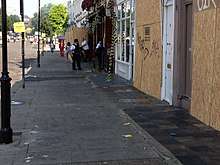
A change of policy came after a confrontation in 1987, when the Carnival was allowed to take place with police adopting a more conciliatory approach. During the 2000 Carnival, two men were murdered; and future policing, while conciliatory, resulted in police deployment in large numbers: upwards of 11,000.
The Mayor of London's Carnival Review Group's report (published in 2004,[33]) led to the parades taking a circular rather than linear route, but a recommendation to relocate the event in Hyde Park has been resisted.[67][36] Some crimes associated with the carnival have taken place on its periphery: in 2007, two teenagers were wounded in separate shooting incidents just outside the carnival area on the Monday evening;[68] however, police said there had been a decline in the number of carnival-linked arrests in comparison with the previous year.[69]
The 2008 Carnival was marred by rioting at the very end of the weekend, involving about 40 youths battling with police, and more than 300 people were arrested.[70] The carnival has come under criticism for its cost to the London taxpayer, with the cost of policing the event more than £6,000,000; however, it is argued that this should be put into context since the carnival is estimated to bring approximately £93,000,000 into the local economy.[37][71]
Despite talk of the 2011 Carnival being cancelled in the wake of the early August riots in the UK that year,[72] it was seen as being relatively peaceful. Five people were arrested for a stabbing at Ladbroke Grove.[73] The victim was one of 86 people who were taken to hospital. In total 245 people were detained by police over the two days of the carnival.[74]
In recent years, there has been much less serious trouble, and it is generally viewed very positively by the authorities as a dynamic celebration of London's multicultural diversity, though dominated by the Caribbean culture. However,there has been controversy over the public safety aspects of holding such a well-attended event in narrow streets in a small area of London. A survey in 2016 commissioned by local Conservative MP Victoria Borwick found that "Nine out of ten residents living along the route of the Notting Hill Carnival flee their homes to escape the 'frightening and intimidating' event."[38]
In 2016 there were over 450 arrests, and five people were hurt in four knife attacks; however, the commander in charge of policing carnival, David Musker, said that the number of arrests had been inflated by the new Psychoactive Substances Act 2016.[75] Based on relative attendance figures, it has been said that crime rates for the Notting Hill Carnival and for Glastonbury or other music festivals are comparable,[76] and Ishmahil Blagrove, author of the book Carnival: A Photographic and Testimonial History of the Notting Hill Carnival, states: "Notting Hill Carnival, compared to Trinidad or Brazil, is one of the safest in the world – not just the second largest – it's one of the safest."[75] A report in 2004 by the GLA Policing Policy Director, Lee Jasper, criticised authorities for not addressing safety issues involved in over a million people attending a small inner-city residential area, quoting the Met Police spokesman Dave Musker, who in November 2016 said: "Each year … we come exceptionally close to a major catastrophic failure of public safety where members of the public will suffer serious injury."[77]
In the three weeks running up to the 2017 event, the police made 656 arrests, a pre-emptive crackdown.[78] There were 313 arrests during the two days of the 2017 Carnival, compared with 454 the previous year.[78] On both days, a minute's silence in tribute to the victims of the Grenfell Tower fire was observed at 3 pm by Carnival-goers, many of whom wore "green for Grenfell".[79][80][81]
During the 2018 event, due to the rising levels of in violent crime in London, police deployed metal detectors to prevent weapons being brought to the event. During the event, 30 police officers were injured in the line of duty, 36 weapons were confiscated and 373 arrests were made by the Metropolitan Police Service.[82][83][84] Homeowners and business owners in the area boarded up their properties to prevent them from being damaged and a company which provided protective boards stated the demand for protection from the carnival had doubled in the last decade.[85]
Since 1987 there have been five deaths caused by violence at Notting Hill Carnival:
- 30 August 1987 – Michael Augustine Galvin, 23, stallholder – stabbed.[86]
- 26 August 1991 – Nicholas John Hanscomb, 38, bled to death after being stabbed in the thigh.[87][88]
- 28 August 2000 – Greg Fitzgerald Watson, 21, stabbed to death after an argument over food.[89]
- 28 August 2000 – Abdul Munam Bhatti, 28; the police treated his attack as racially motivated by a gang of "mainly black males", as described by a witness.[90] Nine men were sentenced for violent disorder in 2002.[91]
- 30 August 2004 – Lee Christopher Surbaran, 27, was shot by a gang using a machine pistol "for showing disrespect"; in 2005, three men were jailed for life for his murder.[92]
Gallery
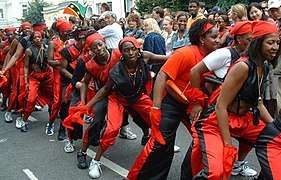 Carnival dancers on Ladbroke Grove (2002)
Carnival dancers on Ladbroke Grove (2002) Notting Hill carnival (2005)
Notting Hill carnival (2005) Resident participation at Carnival (2006)
Resident participation at Carnival (2006)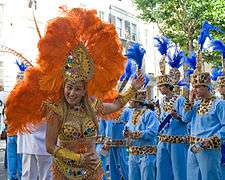 A woman in costume (2006)
A woman in costume (2006)- Notting Hill Carnival (2013)
- Notting Hill Carnival (2014)
- Notting Hill Carnival (2014)
- Notting Hill Carnival (2014)
- Notting Hill Carnival (2014)
- Notting Hill Carnival (2014)
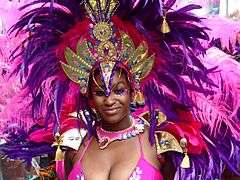 Notting Hill Carnival (2015)
Notting Hill Carnival (2015)- Notting Hill Carnival (2015)
.jpg) Notting Hill Carnival (2017)
Notting Hill Carnival (2017).jpg) Notting Hill Carnival (2018)
Notting Hill Carnival (2018)
See also
- Leeds West Indian Carnival (also known as the "Chapeltown Carnival")
- St Pauls Carnival, Bristol
- Culture of London
References
- ↑ "The Notting Hill Carnival 2018" rove.me
- ↑ "Notting Hill Carnival" Visit London, Official Visitor Guide
- ↑ "50 things you didn't know about Notting Hill Carnival", Time Out 13 July 2016.
- 1 2 "About us", Notting Hill Carnival '13, London Notting Hill Enterprises Trust.
- ↑ BBC – 1Xtra – Black History: "What happened in 1965". Retrieved 17 March 2012.
- ↑ Shiv Malik, "Notting Hill carnival gets off to a peaceful start", The Guardian, 28 August 2011.
- 1 2 Professor David Dabydeen (August 2010), "Notting Hill Carnival", Yesu Persaud Centre for Caribbean Studies, University of Warwick. Retrieved 30 August 2015.
- ↑ "New icons of Englishness unveiled". BBC News (27 April 2006). 10 June 2015.
- ↑ Katherine Schulz Richard, "Carnival is Celebrated Worldwide Just Before Lent", About.com.
- ↑ Caribbean Carnival 1959 brochure.
- ↑ Alan Travis (24 August 2002). "After 44 years secret papers reveal truth about five nights of violence in Notting Hill". The Guardian. London. Retrieved 29 August 2016.
- ↑ "Claudia Jones", AfroCelebrities, 1 August 2013.
- ↑ Stephen Spark, "Carnival Roots", Soca News, 1 October 2009.
- ↑ Margaret Busby, "The Notting Hill carnival has an unsung hero – Rhaune Laslett", The Guardian, 24 August 2014.
- ↑ Davina Hamilton, "'Yes, This Is Notting Hill Carnival's 50th Year'" ("Debora Alleyne De Gazon, creative director of the London Notting Hill Carnival Enterprises Trust, clears up the confusion about the year the event began"), The Voice, 28 August 2016.
- 1 2 Gary Younge, "The politics of partying", The Guardian, 17 August 2002.
- ↑ Michael La Rose, "40 Years of the Notting Hill Carnival: An Assessment of the History and the Future" (PDF). Archived from the original (PDF) on 2013-12-27. , July 2004. Submitted to Joseph Charles Media, publishers of Soca News, for August 2004 Notting Hill Carnival edition of Carnival Groove.
- 1 2 "How Carnival was developed in Britain?" Archived 25 August 2013 at the Wayback Machine. Carnival in Education.
- ↑ Peter Timothy, "Visionaries, Pioneers, Apostles and Healers: The Contribution of Migrants from Trinidad and Tobago to the Development of Black Britain, 1948 to 1986". European Conference on Arts & Humanities, 2013, Proceedings, p. 5. Quoting Tom Vague, 50 Years of Carnival 1959–2009, London: HISTORY talk, 2009, p. 22.
- ↑ Bill Tuckey, "In the beginning...", The Independent, 23 August 2002.
- ↑ Portobello Film Festival.
- ↑ Natasha Ofosu, "Notting Hill Carnival pioneers to be honoured", Soca News, 17 August 2012.
- ↑ Nabeel Zuberi and Jon Stratton (eds), Black Popular Music in Britain Since 1945, Ashgate Publishing, 2014, p. 141.
- ↑ Jamie Clifton, "Things You Never Knew About Carnival, London's Best Street Party", Vice, 21 August 2014.
- ↑ Carnival (2014), p. 290.
- ↑ Henriques, Julian, and Beatrice Ferrara, "The Sounding of Notting Hill Carnival: Music as Space, Place and Territory."
- ↑ "Emslie Horniman's Pleasance". The Royal Borough of Kensington and Chelsea. Retrieved 3 December 2010.
- ↑ "Emslie Horniman's Pleasance: Enchanted gardens". unlike.net. Archived from the original on 24 July 2011. Retrieved 3 December 2010.
- ↑ Abner Cohen (1993). Masquerade Politics: Explorations in the Structure of Urban Cultural Movements. University of California Press. p. 109. ISBN 978-0-520-07838-3. Retrieved 19 August 2011.
- ↑ Emma Griffiths (25 August 2006). "Remembering the Notting Hill riot". BBC News.
- ↑ "Five things you didn’t know about Notting Hill Carnival", Time Out (Now. Here. This), 24 August 2012.
- ↑ Mayor of London – Notting Hill Carnival Review Group. Archived 29 January 2009 at the Wayback Machine.
- 1 2 Notting Hill Carnival: A Strategic Review, Greater London Authority, June 2004.
- ↑ Colourful: Weekday Edition
- ↑ Claire Hu, "'Don't move carnival route'", London Evening Standard, 10 January 2002.
- 1 2 Alice -Azania Jarvis, "The Timeline: The Notting Hill Carnival", The Independent, 26 August 2010.
- 1 2 Michael Ward, "Executive Summary", The economic impact of the Notting Hill carnival, London Development Agency Research, May 2003, p. 9.
- 1 2 Pippa Crerar, "Notting Hill Carnival is 'frightening and drives residents from their homes'", London Evening Standard, 5 July 2016.
- ↑ "Notting Hill Carnival 2011 iPhone app", Source, 2011.
- ↑ "Notting Hill Carnival Gets Free iPhone App", The Londonist, 26 August 2011.
- ↑ "How To Enjoy Notting Hill Carnival 2012", Londonist, 23 August 2012.
- ↑ "Top 10 Tips for Notting Hill Carnival", VisitLondon.com.
- ↑ "Fantastic new photobook celebrates the history of Notting Hill Carnival", It's Nice That, 22 August 2014.
- ↑ "A Black History Month Special Oct 2014: Ishmahil Blagrove discusses his book ‘Carnival’", Flip the Script Book, 10 October 2014.
- ↑ Jamie Clifton, "Things You Never Knew About Carnival", Vice, 21 August 2014.
- ↑ "Carnival: A Photographic and Testimonial History of the Notting Hill" at Ricenpeas.com.
- ↑ Stephen Spark, "Notting Hill Carnival book launch – creating harmony out of adversity", Soca News, 26 November 2014.
- ↑ Dominic Ponsford, "Journalists charged £100 to cover Notting Hill Carnival and told to share work with organisers", Press Gazette, 19 August 2015.
- ↑ "Notting Hill Carnival 2015: Journalists to stage boycott over £100 accreditation fee", The Independent, 25 August 2015.
- ↑ "New Media Policy and Official Media Centre at Carnival" Archived 24 August 2017 at the Wayback Machine., Press release, Notting Hill Carnival Guide, 16 June 2017.
- ↑ Stephen Spark, "Notting Hill Carnival promises a media makeover", Soca News, 4 July 2017.
- ↑ Stephen Spark, "Notting Hill Carnival launches into the past", Soca News, 27 July 2016.
- ↑ "Notting Hill Carnival celebrates golden jubilee", Arts Council England, 24 August 2016.
- ↑ "In pictures: Fifty years of the Notting Hill Carnival", BBC News, 28 August 2016.
- ↑ Andy Malt (18 August 2016). "Boiler Room to broadcast Notting Hill Carnival livestream". Complete Music Update. Retrieved 1 September 2016.
- ↑ Reidy, Tess (13 August 2016). "No mud but all the music: fans flock to watch festivals online". The Guardian. ISSN 0261-3077. Retrieved 1 September 2016.
- ↑ David Renshaw. "This Is How You Can Stream Notting Hill Carnival Around The World". The FADER. Retrieved 1 September 2016.
- ↑ "We've Teamed Up with Boiler Room and Deviation to Give You a Taste of Notting Hill Carnival". Thump. 26 August 2016. Retrieved 1 September 2016.
- ↑ SBTV (26 August 2016). "SBTV Partners with Boiler Room for Notting Hill Carnival broadcast – SBTV". Archived from the original on 1 September 2016. Retrieved 1 September 2016.
- ↑ Will Lynch (26 August 2013). "Boiler Room streams live from Notting Hill Carnival". Resident Advisor. Retrieved 1 September 2016.
- ↑ "Live Stream Boiler Room from Notting Hill Carnival". Retrieved 1 September 2016.
- ↑ "Boiler Room at Carnival: stream if you wanna go harder". Retrieved 1 September 2016.
- ↑ Sarah Phillips, "Robert Golden's best photograph: the 1976 Notting Hill carnival riots", The Guardian, 13 March 2013.
- ↑ "Riot shields – protective or aggressive?", New Scientist (Vol. 75, No. 1070), 22 September 1977, p. 739.
- ↑ Roger Fowler, Language in the News: Discourse and Ideology in the Press, p. 248.
- ↑ Tony Moore, Policing Notting Hill: Fifty Years of Turbulence, Waterside Press, 2013, p. 195.
- ↑ Chirag Trivedi, "Carnival's route to success", BBC News, 27 August 2004.
- ↑ Martina Smit, "Teen shootings mar Notting Hill Carnival", Guardian Series, 28 August 2007.
- ↑ Matthew Moore and agencies, "Notting Hill Carnival ends with boy's shooting", The Telegraph, 28 August 2017.
- ↑ James Orr and agencies, "Notting Hill carnival ends with police battling troublemakers", The Guardian, 26 August 2008.
- ↑ Pav Akhtar, "London cashes in on the carnival", The Daily Telegraph, 21 August 2003,
- ↑ Lloyd Bradley, "Don't confuse Notting Hill carnival with the riots" Archived 7 April 2014 at the Wayback Machine., U TV, 25 August 2011.
- ↑ Caroline Davies (30 August 2011). "Notting Hill carnival: 16-year-old arrested after stabbing". The Guardian. London.
- ↑ "Notting Hill Carnival stabbing: Boy among five arrested". BBC News. 30 August 2011.
- 1 2 Damien Gayle (30 August 2016). "Notting Hill carnival arrests hit record high". The Guardian. Retrieved 30 August 2016.
- ↑ Greg Hurst, "Glastonbury Festival has worse crime rate", The Independent, 1 September 2000.
- ↑ Lee Jasper, "Notting Hill carnival is unsafe. But, like Grenfell, authorities ignore the warnings", The Guardian, 25 August 2017.
- 1 2 Jamie Grierson and Damien Gayle, "Notting Hill carnival arrests down after controversial crackdown", The Guardian, 29 August 2017.
- ↑ Jemma Crew, "Notting Hill Carnival pays tribute to Grenfell fire victims with emotional minute silence", The Independent, 29 August 2017.
- ↑ Lauren Pilat and Natasha Salmon, "Notting Hill Carnival-goers praised for Grenfell disaster response", London Evening Standard, 29 August 2017.
- ↑ "Notting Hill Carnival: Thousands enjoy sound, samba and sun", BBC News, 29 August 2017.
- ↑ "Met officers thank Londoners for spectacular Notting Hill Carnival". Mynewsdesk. Retrieved 2018-08-28.
- ↑ "Over 370 arrests were made at Notting Hill Carnival and one person was stabbed". The Independent. Retrieved 2018-08-28.
- ↑ "Notting Hill Carnival 2018: Police to use stop and search powers in violence crackdown". Sky News. Retrieved 2018-08-28.
- ↑ "Homes and businesses on Notting Hill Carnival route boarded up over fears of being destroyed - i". i. 2018-08-26. Retrieved 2018-08-28.
- ↑ "Police informer is jailed for perjury over knife murder: Testimony led to man's life sentence for killing of stallholder at 1987 Notting Hill Carnival". The Independent. London. 2 July 1993.
- ↑ "Carnival victim's killer still being hunted" Archived 22 April 2014 at the Wayback Machine., This Is Lancashire, 25 August 2001.
- ↑ "Tragic dad in carnival rap" Archived 22 April 2014 at the Wayback Machine., This Is Lancashire, 7 September 2000.
- ↑ "Carnival murder footage released", BBC News, 11 October 2000.
- ↑ "'Racial motive' for carnival murder", BBC News, 5 September 2000.
- ↑ Paul Cheston (2 May 2002). "Gang jailed for carnival rampage". London Evening Standard. Retrieved 31 August 2016.
- ↑ Alex Galbinski, "Gang trio jailed for murder", The Times Series (Newsquest), 2 August 2005.
Further reading
- Abner Cohen, "Drama and Politics in the Development of a London Carnival", in Ronald Frankenberg (ed.), Custom and Conflict in British Society, Manchester University Press, 1982, pp. 313–44.
External links
| Wikimedia Commons has media related to Notting Hill Carnival. |
- Official website
- "The Official Guide to Notting Hill Carnival", Street Event Company.
- Notting Hill Carnival at CarnivalInfo.com
- The origins and men who started Notting Hill Carnival [...] interview with Peter Joseph, part 1 on YouTube
- The origins and men who started Notting Hill Carnival [...] interview with Peter Joseph, part 2 on YouTube
- "The art(s) of Carnival", Arts Council England podcast on 50th anniversary of Notting Hill Carnival, 2016. Soundcloud. See also "Notting Hill Carnival celebrates golden jubilee", Arts Council England, 24 August 2016.
- London School Of Samba – Notting Hill Carnival Archive – The themes paraded by the London School of Samba since their debut year in 1984.
